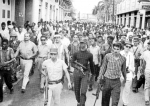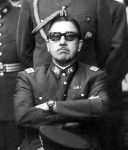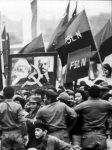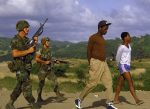
The United States (US) and the Soviet Union (USSR) did not go to war with each other between 1945 and 1991. Instead, both superpowers sought to wield global power and influence by manipulating smaller nations. They did this in many ways: through diplomacy, treaties and alliances; by providing aid or trade deals; by supporting friendly political groups or leaders; and by supplying arms, military equipment and training. The US and USSR also exerted pressure on ‘unfriendly’ foreign governments. In extreme cases, American and Soviet agents worked to change or overthrow these governments. In Europe, the Soviets installed socialist regimes loyal to Moscow, while elsewhere the Central Intelligence Agency (CIA) orchestrated or supported coups that displaced socialist or left-leaning governments. These interventions often brought about disruption, conflict and significant human suffering. During the Cold War, several democratically-elected leaders were replaced with puppet governments, military juntas or dictators who were authoritarian, violent and corrupt.
Foreign interference became a hallmark of the Cold War, even its first months. Soviet political interference in eastern European nations was a contributing factor to the Cold War. During the late 1940s, the United States offered support and inducements to shape the political future of smaller nations. These included promises of political recognition and backing, promises of financial aid (such as the Marshall Plan), bilateral and multilateral treaties, economic and trade agreements, and the provision of military training, weapons and equipment. Some governments and politicians could not be bought, however. Where political leaders were determined to adopt socialist or nationalist policies, the US adopted punitive measures, such as trade embargoes or the suspension of aid. Where this failed, CIA agents were often tasked with bringing about what is today referred to as “regime change”. They did this by identifying enemies of the government or potential coup leaders, then providing them with funds, weapons, intelligence and political backing. These American agents were seldom directly involved in coups or assassinations but they certainly contributed to their success.
During the Cold War, the United States and its allies supported Cold War coups, attempted coups or insurgencies in a number of locations. Countries that endured Cold War-related regime change included Tibet (1950), Iraq (1958), Cuba (1960), Bolivia (1970), Uganda (1971), Argentina (1976), Pakistan (1977), Afghanistan (1978), Iran (1979), the Central African Republic (1979) and Turkey (1980). Both the US and USSR were involved in civil wars in Malaya (1948-60), Laos (1953-1975), Cambodia (1967-75) Ethiopia (1974-91), Lebanon (1975-90) and El Salvador (1980-92). During the Cold War Washington sent American troops into Vietnam (1965-75), the Dominican Republic (1965), Lebanon (1982), Grenada (1983) and Panama (1989). Some of these Cold War coups and interventions are briefly outlined below:
Iran (1953)

Iran is a Middle Eastern nation, located between Turkey, Iraq, Afghanistan, Pakistan and the Persian Gulf. Its rich oil reserves made Iran a coveted ally, even before the outbreak of the Cold War. British and Soviet forces invaded Iran during World War II, promising to restore its sovereignty and independence later. Soviet troops breached this agreement, however, and remained ensconced in northern Iran after the war. The Soviets tried to engineer the break up of Iran, creating pro-Moscow republics and fomenting a civil war. Soviet forces did not withdraw until mid-1946, under pressure from the US. Many Iranian nationalists remained friendly to Moscow and hostile to Britain and the US. In 1951 Iran’s new prime minister, Mohammed Mossadegh, nationalised the country’s oil industry, which had been developed and owned by British interests. Britain responded by blocking purchases of Iranian oil, a move that triggered an economic and political crisis in Iran. Fearing that Mossadegh might align with the Soviet Union, the US and Britain began plotting his removal. In early 1953 the CIA launched Operation Ajax, a campaign to discredit Mossadegh and force his dismissal by Iran’s reigning monarch, the Shah. This culminated in Mossadegh’s removal in an August 1953 coup d’etat. The Shah became Iran’s political ruler as well as its head of state. The Shah of Iran remained a staunch Western ally in the Middle East, though he suffered growing unpopularity within his own country. The Shah was himself overthrown by an Islamist revolution in 1979 and control of the country passed to the Ayatollah Khomeini.
Guatemala (1954)

Guatemala is a small central American nation, sandwiched between Mexico and Honduras. Between 1931 and October 1944 Guatemala was ruled by Jorge Ubico, a dictatorial leader with pro-American leanings. Ubico gave free rein to American companies in Guatemala, leading to low wages and the mistreatment of local workers. In October 1944 Ubico was overthrown by a coup led by disgruntled students and labourers. Juan Jose Arevalo, a liberal-minded philosopher professor, was elected as the country’s president. Arevalo implemented a series of social reforms, dubbed “spiritual socialism”. Voting rights were expanded and civil rights guaranteed; education and literacy programs were created; while laws were passed to protect the rights of workers. In 1952 Arevalo’s successor, Jacobo Arbenz, initiated a program of land reform, seizing more than one million acres of farmland. The biggest loser from these reforms was the US-owned United Fruit Company, which had long profited from imports of cheap Guatemalan bananas. In 1953 the CIA began training and supplying Guatemalan exiles. They invaded the country in June 1954, backed by US air support. Arbenz was forced to resign and flee, leaving the government in the hands of military officers led by Castillo Armas. Guatemala was governed by military juntas for the remainder of the Cold War. Its leaders wound back the reforms of 1945-54, banned political parties, refused free elections and used the military to pursue, imprison and execute political dissidents. Despite its human rights breaches, Guatemala’s military junta continued to receiving backing and funds from American leaders, particularly Ronald Reagan.
Dominican Republic (1961-65)

The Dominican Republic is a small nation in the Caribbean. Like its neighbour Cuba, the Republic was strongly influenced by the United States. Between 1930 and 1961 the Dominican Republic was ruled by US-backed strongman Rafael Trujillo. Though he proclaimed a commitment to freedom and democracy, Trujillo was a murderous dictator who eliminated opposition wherever it emerged. Like other Latin American despots, Trujillo retained US support by exploiting Cold War fears. By the late 1950s, international opposition to Trujillo’s regime was intense. In November 1960 Trujillo’s henchmen murdered the Mirabal sisters, three women involved in opposition to his government. Incoming US president John F. Kennedy was unwilling to risk international embarrassment by maintaining support for the Dominican dictator. Kennedy cut aid to Trujillo and imposed economic sanctions on the Dominican Republic. In May 1961 Trujillo was assassinated by rebels in receipt of some CIA support. The Republic held its first democratic elections in 1962 but succumbed to three years of power struggles and political instability. US president Lyndon Johnson ordered 20,000 American troops into the Dominican Republic in April 1965, supposedly to quash a communist revolution. By late 1966, the country was in the hands of Joaquin Balaguer, a former ally of Trujillo’s. Balaguer ruled for much of the next three decades, employing similar tactics to Trujillo and receiving support and aid from Washington.
Brazil (1964)

In 1964 the United States orchestrated a coup d’etat in Brazil, the largest nation in South America. Brazil had fought with the Allies during World War II, receiving US military equipment and considerable financial aid. The Brazilians used this aid to industrialise and jump-start their underdeveloped economy. During the late 1940s and 1950s Brazil remained a staunch ally of the US, banning communist parties and signing a military treaty with Washington (1952). Later Brazilian governments, however, adopted a different course. The formation of the Petrobras oil company gave the Brazilian government a monopoly over the nation’s sizeable oil reserves. President Joao Goulart (1961-64) was a moderate leftist who implemented democratic reforms, increased spending on education and attempted to tax foreign companies trading in Brazil. Goulart and his predecessors also recognised and traded with the People’s Republic of China and the Castro regime in Cuba. These policies caused consternation among Brazilian conservatives and in Washington DC. In early 1964 the CIA began supporting anti-Goulart groups and promoting public unrest against his government. Brazilian officers seized power at the beginning of April 1964, forcing Goulart to seek exile in Uruguay. The military governed Brazil for the next two decades, assisted by American political backing and financial aid.
The Democratic Republic of Congo (1965)
The Democratic Republic of Congo is a central African nation. In 1945 it had a population of around 11 million. Formerly a Belgian colony, the Congo became independent in June 1960. Its first democratically elected prime minister, Patrice Lumumba, was an anti-colonialist who sought to reduce Western influence in his country. Facing opposition from the Belgian-controlled Congolese military, Lumumba sought aid and weapons from the Soviet Union. These communications were watched by US agents, however, and Washington was concerned about the Congo’s large deposits of copper and uranium falling into Soviet hands. Belgian military officers and CIA operatives began working together to unseat Lumumba. They were involved in his arrest, torture and execution in January 1961. In November 1965 a CIA-backed coup d’etat brought General Joseph Mobutu to power in the Congo. Mobutu would rule as a military dictator for more than three decades. He abolished the office of prime minister, banned all political parties but his own, and used his armed forces to eliminate opposition groups. Washington maintained its backing for Mobutu, despite his violent and undemocratic rule.
Southern Africa
“The white minority governments of South Africa and Rhodesia have been derided for their claims they faced a total onslaught from radical black nationalism, manipulated and directed by the forces of communism, or that their country represented the front line of the Cold War in southern Africa. The inference is that this was a mirage, an imagined threat… But it has to be said that black nationalist movements did contain Marxist intellectuals.”
Sue Onslow, historian
The Cold War also shaped the political development of African countries south of the Equator. The continent’s most powerful and prosperous nation was South Africa, a former British colony that gained independence in 1910. From 1948 South Africa was governed by the Nationalists, a white minority party committed to a program of racial segregation it called apartheid. In 1950 the Nationalist regime passed the Suppression of Communism Act. On this surface, this legislation empowered the government to eliminate the threat posed by communism in South Africa. In reality, it was used to crush opposition to apartheid and silence leaders like Nelson Mandela. Though many in Western countries opposed apartheid on moral grounds, South Africa remained a significant Cold War ally. In the West African country of Angola, Cold War powers supported rival factions in a bloody civil war that erupted in 1975. The Soviet and Cuban-backed People’s Movement for the Liberation of Angola (MPLA) controlled most of Angola by 1980, forcing the withdrawal of American and South African troops. Mozambique was also paralysed by a civil war (1977-92) where opposing forces were backed by Cold War protagonists. Communist China became heavily involved in Africa in the 1960s, forging trade links, building large infrastructure projects and railways, and supplying arms and equipment to liberation movements across the continent.
Chile (1973)

One of the most infamous Cold War coup d’etats occurred in the South American nation of Chile. Neutral during World War II, Chile’s government later aligned with the United States, signing treaties for financial aid (1947) and military assistance (1952). This alliance was threatened by the rise of Salvador Allende, a moderate socialist who had served as a minister in previous governments. Allende stood several times for the Chilean presidency, coming close to victory in 1958. This rang alarm bells in Washington, leading to a CIA-funded propaganda campaign to undermine and discredit Allende. When Allende was elected president in 1970, CIA agents began bribing Chilean politicians and agitating for a military coup. During his short time in power, Allende initiated land reform projects, authorised the lifting of wages and increased spending on healthcare and education. He also opened diplomatic relations with communist nations, including Cuba, China and North Korea. Most concerning to Washington was Allende’s plan to nationalise Chilean industries, including several American-owned copper mines. US president Richard Nixon ordered his advisors to “make the [Chilean] economy scream”, leading to economic boycotts and embargoes and the suspension of foreign aid. On September 11th 1973 Chilean military officers, backed by the CIA, overthrew Allende. His government was replaced by a repressive military dictatorship headed by General Augusto Pinochet. In the first months of Pinochet’s rule, more than 40,000 Chileans were arrested and as many as 5,000 either vanished or were murdered. The Pinochet regime was supported by the US until 1976 when its human rights abuses were exposed to the world.
Nicaragua (1979)

The small central American nation of Nicaragua lies between Honduras and Costa Rica. Nicaragua gained its independence from the Spanish in 1821. This was followed by decades of political turmoil and shifting governments. During this period the US government and American business interests wielded considerable influence over the country. Between 1927 and 1979 Nicaragua was ruled by members of the Somoza family, whose loyalty to Washington and American capitalists was matched only by their greed and corruption. Toward the end of their reign, the Somozas were worth almost $US1 billion while Nicaragua remained one of the poorest nations on earth. The election of Jimmy Carter in 1976 triggered a shift in US policy and the withdrawal of support for the Somoza dynasty. In July 1979 Nicaragua was seized by the Sandinista Front, a socialist guerrilla movement inspired by Castro’s revolution in Cuba. When Ronald Reagan came to office in 1981, he condemned the Sandinistas for their ties with Cuba and the Soviet Union. Under the Reagan Doctrine, the CIA was ordered to organise, train and arm a counter-revolutionary force to seize power in Nicaragua. Between 1982 and 1984 the CIA handed more than $US50 million to these counter-revolutionaries, known as the Contras. When the US Congress refused further payments to the Contras, Reagan’s administration raised funds by selling arms to Iran – despite the latter being in the hands of Islamic fundamentalists. The Iran-Contra affair, as it became known, scandalised the Reagan administration, though much of the blame was shouldered by Reagan’s subordinates. The Contras conducted a guerrilla war against the Sandinista government for almost a decade, committing hundreds of murders and other human rights abuses.
Grenada (1983)

One of the most controversial US interventions of the Cold War occurred in Grenada. A tiny island nation north of Trinidad and Venezuela, Grenada had a population fewer than 100,000 people. For almost two centuries it had been a British colony; it remained a member-state of the British Commonwealth after being granted independence in 1974. In March 1979 the Grenadian government was seized by a moderate Marxist group, the New Jewel Movement (NJM), led by Maurice Bishop. In October 1983 hardline elements of the NJM, dissatisfied with the lack of socialist progress in Grenada, arrested and executed Bishop. The new regime declared martial law and sought aid from Castro’s Cuba. Fearing Grenada would become a pawn of Moscow and Havana, and a possible refuelling stop for Cuban planes carrying mercenaries to central America, Ronald Reagan decided to act. Days after the October 1983 coup Reagan ordered more than 7,000 US troops into Grenada, under the pretext of protecting US citizens and other civilians. Reagan gave this order without the approval or knowledge of British prime minister Margaret Thatcher, despite Grenada being a British Commonwealth nation. The US landings in Grenada prompted outrage around the world. A total of 108 United Nations member states condemned the invasion of Grenada, calling it “a flagrant violation of international law”. Critics claimed Reagan ordered the invasion for publicity, seeking an easy military victory over a communist regime in Latin America. US forces withdrew in December 1983 after removing the NJM from power and installing a pro-American government.

1. The US and USSR did not go to war between 1945 and 1991, however, both superpowers used their assets and agencies to influence the political development of smaller countries.
2. Both superpowers funded ‘friendly’ political groups and movements, while funding, supplying or orchestrating coups d’etat to remove ‘unfriendly’ governments or leaders.
3. The superpowers were also involved in so-called “proxy wars” – conflicts where they supplied and supported one side, without American or Soviet troops being directly involved.
4. American CIA agents were particularly active in organising and funding anti-communist coups, such as Augusto Pinochet’s removal of Salvador Allende in Chile in September 1973.
5. This meddling in the affairs of other nations often had devastating effects for the locals, bringing to power leaders who were undemocratic, dictatorial, brutal and corrupt.
Content on this page is © Alpha History 2018-23. This content may not be republished or distributed without permission. For more information please refer to our Terms of Use.
This page was written by Jennifer Llewellyn and Steve Thompson. To reference this page, use the following citation:
J. Llewellyn et al, “Coups and proxy wars”, Alpha History, accessed [today’s date], https://alphahistory.com/coldwar/coups-proxy-wars/.
